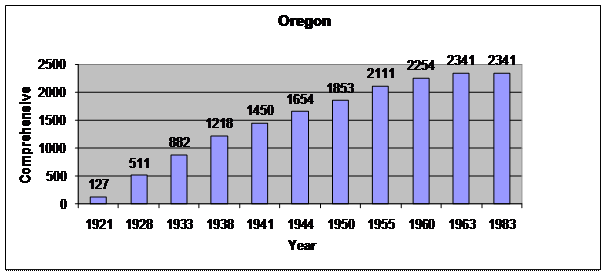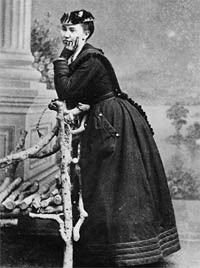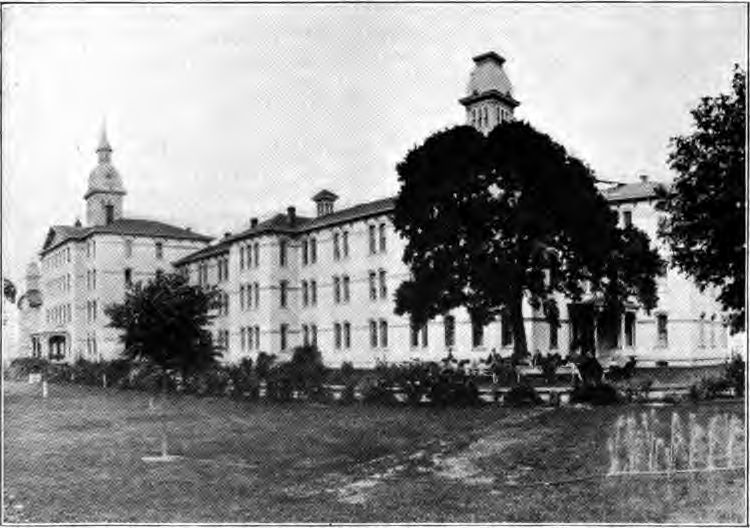Oregon
Number of
Victims
2,341 sterilizations are recorded to have occurred in the state of Oregon from 1921 until 1983 (Lombardo, p. 293). However, in governor John Kitzhaber's 2002 “Human Rights Day” apology on behalf of the state, it is noted that 2,648 people were sterilized (Josefson, p. 1). Of the 2,648 people accounted for, 1,713 (65%) were women and 935 (35%) were men. Victims, drawn mainly from state institutions like mental hospitals, facilities housing developmentally disabled persons, and prisons, were deemed mentally ill (about one third) or deficient, or in earlier time periods, “feeble-minded” (almost 60%).
Period
During Which
Sterilizations Occurred
The first Oregon Eugenics law was
signed into law in 1917 and was utilized within the year (Eccleston, p.
2). No sterilizations were reported in 1922 because the 1917 law was
nullified by the Marion County Circuit Court and the 1923 law had not
yet been passed (Largent, p. 200). The rate of sterilizations
was greatest
during the 1920s and 1930s, yet substantial number of sterilizations
did occur
after the end of World War II (Paul, p. 460). The Oregon eugenics
program continued to sterilize patients until the 1960s and the
law continued to be used sparing after the 1960s until its repeal in
1983. Two hundred and seventeen patients were sterilized after 1967
(Largent, p. 206).
Temporal Pattern and Rate of Sterilizations

Passage of
Law
Bethenia Owens-Adair, the public
leader of Oregon's eugenics
law (see below), authored and promoted a sterilization law in 1907 (Largent, p.195). She
continued to introduce it every year until it was finally passed and
was signed
into law in 1917 (Currey, pp. 47-50). The first law was passed in 1909
to “to
prevent the procreation of confirmed criminals, insane persons, idiots,
imbeciles and rapists,” by large margins in the Oregon Legislature
(Largent, p.
192), but was vetoed by Governor Chamberlain as being overly
complicated and
not including enough safeguards for those convicted under it (Paul, p.
456). The Governor sent a personal letter to Owens-Adair explaining why he could not support the bill (Largent, p. 195).
In 1913, with the newly elected Governor West, the Oregon Legislature passed another eugenics bill that was signed into law (Paul, p. 456). Opponents, led by Lora Little and the Anti-Sterilization League, campaigned against the bill and forced a state referendum which went to voters on November 4, 1913 (Largent, p. 198). The advocacy of the Portland-based Anti-Sterilization League was largely credited with ensuring the law was subjected to a referendum, and contributing to its defeat (Paul, p. 456). Member of that group argued that the law was overly broad and that supporters had not sufficiently proven that sterilization was an effective or necessary reform technique, pointing to the success of former prison-colony nation Australia (Largent, p. 193). Voters rejected the new law 53,319 to 41,767 (Largent, p. 199).
The lobbying effort for eugenics regrouped and continued vigorously (Owens-Adair, p. 71), and another law was passed and signed by Governor Withycombe in 1917 that created Oregon's Eugenics Board (Eccleston, p. 2). The law provided for the sterilization of all “feebleminded residents of state prisons and hospitals.” Public scrutiny was decidedly more muted as proponents tried to reframe the purpose of the law to voters mostly distracted by World War I (Largent, p. 194). The law was amended in 1919 to include an appeals process for patients and their families, and was codified into Oregon statute in 1920. In 1921, the Marion Circuit Court struck down, in Cline v. Oregon State Board of Eugenics, as unconstitutional Oregon's law as violating the U.S. Constitution's ban on cruel and unusual punishment. The case was brought by Jacob Cline, a rural farmer convicted of incestual child molestation, who according to law was examined at his state prison and found to have feeblemindedness and a sexual perversion. His lawsuit effectively ended eugenics in Oregon for a time (Largent, pp. 194-195). At that time, 127 patients had already been sterilized (Laughlin, pp. 147, 318).
A new law was passed and signed in 1923, bringing eugenics back to Oregon. Supporters stressed the new law as being non-punitive and therapeutic for both the patient and society, and it survived challenges even though the substantive language of the new law was almost entirely the same. The law permitted the sterilization of “persons, male or female, who are feeble-minded, insane, epileptic, habitual criminals, moral degenerates and sexual perverts, who are, or … who are likely to become, a menace to society” (Cruz). Owens-Adair pushed for the inclusion of provisions in the new law to target especially sexual offenses (Paul, p. 457). For the first time it was expanded to include all residents, regardless of institutionalized status. Similar efforts led the push for marriage limits on “deviants” (Laughlin, p. 343). In 1925 the Oregon Legislature passed an amendment to the eugenics law to include all those convicted of rape and sodomy to the statute (Landman, p. 77). Oregon’s laws were further legitimized with the 1927 United States Supreme Court decision, in Buck v. Bell, that upheld the federal constitutionality of eugenics (Largent, p. 195).
After slowly decreasing in speed, scope and scale since the 1950s, the Eugenics Board was renamed and reformed in 1967, and loosely disbanded in 1975 (Currey, p. 134). The Oregon Legislature repealed the 1923 law establishing legal eugenics in 1983. The debate over the Governor’s aforementioned 2002 apology “has uncovered decades of lost records and unknown cases,” including at “least one woman died as a result of a forced hysterectomy” (Cruz).
Groups
Identified in
the Law
The earliest Oregon sterilization bill applied to all feeble-minded people “…to prevent the procreation of confirmed criminals, insane persons, idiots, imbeciles and rapists” (Largent, p. 192).
The 1917 law used to sterilize people singled out, “…those feeble-minded, insane, epileptic, habitual criminals, moral degenerates and sexual perverts” (Laughlin, p. 146). It was worded broadly enough to encompass a large swath of society deemed unfit for procreation. The “mentally deficient” often had sterilization as a precondition for leaving the state’s institutions (Paul, pp. 458-459). “Rapists, and other insane people,” were included in a vaguely worded section, which was able to encompass a variety of sexual deviants that often fell victim to the scorn of the State Eugenics Board. Homosexual men were often the main targets of this discrimination (Boag, p. 210).
Process of
the Law
The
process of the law required
had state hospitals and prisons to review inmates and make
recommendations to
the State Eugenics Board for possible sterilizations. The Board itself
was
comprised of the directors of the four main institutions, the members
of the
State Board of Health and the Secretary of the State Board of Health.
The Board
would then review and make decisions on the validity of the inmate’s
feeblemindedness. Members of the Board served without
compensation
(Laughlin, p. 88) and an order of sterilization required a majority
vote
(Landman, p. 76).
Two
years after the initial 1917 law, a patient appeals
process was implemented so an inmate could appeal his or her
sterilization
order to the local county court within fifteen days (Largent, pp.
194-195).
Aforementioned changes to the law later allowed for non-incarcerated or
institutionalized people to be drawn into the process, thusly expanding
its
scope. Although all laws enacted throughout the early twentieth century
were compulsory, it was considered the policy of the Eugenics Board to
have the
consent of the patient and/or his guardians as to not provoke a popular
or
legal backlash. Even though a lack of appeal to a local court was often
seen as a sign of consent, if objection was raised anytime during the
process,
it was usually halted. This being said, it was often easy to obtain
consent
from families supportive of eugenics policy, or patients wishing to be
released
back into the general population (Paul, p. 458).
Precipitating
Factors
and Processes
The passage of a comprehensive eugenical sterilization law in Oregon traces its history back to Oregon's admittance to the Union. Leaders of "progressive movements” in Western states were main forces behind movements such as prohibition, suffrage, and social reform (Currey, pp. 86-89). Eugenical sterilization created what scholar David Noble called “a paradox of progressive thought” (quoted in Largent, p. 188), referring to the inherent contradiction between social reform and the damage caused by eugenics in America. Its development in Oregon followed a national backlash against what was perceived to be a widespread moral and racial decline. Immigration from southern and eastern Europe and the procreation of the “feebleminded” pushed a majority of states to approve sterilization laws in the first half of the twentieth Century. Prominent supporters of eugenics, like Harry Laughlin, were also big supporters of other laws to homogenize the United States racially, like the Immigration Act of 1924 (Largent, p. 189).
Ideas about eugenics and the genetically unfit may have also been passed to Oregon from the "Eugenics in New Germany" exhibit which was shown both in Salem and Portland. The exhibit from Germany displayed population trends in Germany, explained mendelian laws of heredity, and showed how sterilization could be used to reduce "the transmission of physical, mental, and behavioral defects" (Schneider, p. 71). In Salem the exhibit was set up at the city's YMCA and it received positive reviews from local newspapers (Schneider, p. 74). Promoters of the exhibit have said it was shown to seven to eight thousand residents in Salem and another forty thousand residents in Portland, meaning roughly one in twenty Oregonians saw the exhibit in 1935 (Schneider, p. 74). More significantly, Currel and Cogdell suggest that “there is considerable circumstantial evidence that, just as Laughlin's use of eugenics exhibits influenced passage of the 1924 National Origins Act, the Nazi eugenics exhibit powerfully motivated the legislature's expansion of the use of coerced sterilization in Oregon”(p. 376).
Groups
Targeted and
Victimized
Oregon’s laws targeted three main groups:
The first group, the mental and physcially
disabled, were generally clumped under the title of "insane" (Largent,
p. 203). They were individuals that were considered to the lack
intelligence or means to rear
children in a modern society. Such people were deemed simple or
feebleminded
and drawn mainly from state hospitals and small towns. Many of these
individuals were housed in the Oregon State Hospital in Salem or the
Eastern Oregon State Hospital in Pendleton (Largent, p. 203).
The second group,
"habitual criminals", were people convicted of three or more felonies,
drawn
mainly from state prisons (Largent, p. 203). Sometimes habitual sexual
offenders used sterilization as
an
avenue to again gain parole (Largent, p. 205). They were seen as too
risky for society in
that
they would undoubtedly raise families of ill and criminal
regard. Prisoners were subjected to castration because of their
sexual behavior inside prison; in order to solve the problem of sodomy
within prisons men were recommended for surgery (Largent, p. 205).
The third and
final group, were “sexual perverts and moral degenerates,” and came
from both
state prisons and hospitals (Largent, p. 195). The real distinguishing feature of
Oregon's sterilization compared to other states was its especially virulent targeting of "sexual deviants."
Although this included women at the margins of society, rapists and
child
molesters (Boag, p. 208), homosexual men were prosecuted and persecuted
at
higher rates (Owens-Adair, pp. 110, 183). Homosexual political and
cultural
scandals in Portland incited widespread outrage to homosexuality
(Largent, p.
195), and as seen as a mental illness in the United States until the
1960s, was
included under the charge of eugenics proponents.
This led to a greater use of castration in Oregon as opposed to
vasectomy, which is a much less invasive surgery, rather than just
wanting to prevent the spread of unfavorable traits "authorities wanted
to unsex them" (Largent, p. 205).
Other
Restrictions
Placed on Disabled People
In Oregon, like other states with eugenics laws, sterilization was often a precondition of being released from prison or from a state mental institution (Paul, p. 458). It was often individuals at the margins of society who were targeted as feeble-minded or perverseand they often had little choice but to consented to sterilization in order to regain their freedom. Even after release there was certainly a stigma associated with having been targeted by the Oregon Eugenics Board, based on the public characterizations made by eugenics proponents like Bethenia Owens-Adair. This stigma was often intense because the individuals targeted, such as homosexuals or the mentally ill, would have naturally already been at the far periphery of societal approval.
Major Proponents
 (Photo
origin: Oregon Historical Society; available at
http://www.ohs.org/education/focus/breaking-tradition.cfm)
(Photo
origin: Oregon Historical Society; available at
http://www.ohs.org/education/focus/breaking-tradition.cfm)
“Feeder institutions” and institutions where sterilizations were performed
 (Photo origin: Wikipedia.com;
available at
http://commons.wikimedia.org/wiki/Image:Oregon_State_Hospital_1920.jpg)
(Photo origin: Wikipedia.com;
available at
http://commons.wikimedia.org/wiki/Image:Oregon_State_Hospital_1920.jpg)
The Oregon State Hospital (formerly the Oregon State Hospital for the Insane) was a primary institution for sterilization; it is located in Salem (Brockley, p. 24). The Oregon State Hospital is open to this day and serves as the state’s primary mental health facility (Wikipedia "Oregon State Hospital"). There is no mention on the Hospital’s website of its eugenical past (Oregon.gov "Oregon State Hospital").
History of the Oregon State Hospital
In 1907 the name of the hospital was changed from the Oregon State Insane Asylum to the Oregon State Hospital to emphasize its curative function. To cover the costs of maintaining the hospital patients were forced to work twelve-hour days despite an eight hour work day law (Larsell, p. 315). The led to a dramatic arrest of the Superintendant but the charged were dropped and the patients continued to endure long work hours (Larsell, p. 315).
By 1918 the Oregon State Hospital was performing sterilizations of undesirables including the "insane", the "habitual criminal", the "moral pevert" and the "sexually deviant" (Largent, p. 203). Largent claims, "Women made up 59 percent of the 509 sterilizations recorded at the Oregon State Hospital in Salem between 1918 and 1941. Over 90 percent of them received salpingectomies; the rest were given ovariectomies. Of the 207 men sterilized, just over 68 percent were castrated, while the rest received vasectomies (p. 203).
(A chart included on page 204 details the number of each operation in each year from 1918 to 1941). The peak year of sterilization was 1937 with 44 sterilizations performed in total. While vasectomies were common in other states at this time the majority of men sterilized at the Oregon State Hospital received castrations (Largent, p. 205). Sterilization in Oregon was also aimed at ridding the state of homosexuals along with other stigmatized groups (Largent, p. 205). Oregon officially ended state sponsored Sterilization 1983 with the abolishment of the Board of Protection (Largent, p. 206). In total around 2,500 individuals were sterilized in Oregon (Largent, p. 206).
Currently the hospital is known for its poor conditions and a tragic poisoning incident, which killed 47 in 1942. Also the hospital was featured in the movie "One Flew Over the Cuckoo's Nest".
 (Photo origin: Oregon State Archives; available at http://arcweb.sos.state.or.us/state/control/pics/fairviewext.htm)
(Photo origin: Oregon State Archives; available at http://arcweb.sos.state.or.us/state/control/pics/fairviewext.htm)
The Oregon State Institute for the Feeble-Minded, in Salem, was the largest center of eugenics (Brockley, p. 24), and closed in 2000 (Cruz). The Oregon State Institute for the Feeble-Minded was later renamed the Fairview Training Center. Fairview was established by the legislature in 1907 and the institution was created as a "quasi-educational institution" charged with educating the "feeble-minded" and caring for the "idiotic and epileptic" (Oregon Blue Book "Fairview Training Center").
History of the Oregon State Institute for the Feeble-minded
 (Photo
origin: Wikipedia.com; available at
http://en.wikipedia.org/wiki/Image:Oregon_State_Pen.JPG)
(Photo
origin: Wikipedia.com; available at
http://en.wikipedia.org/wiki/Image:Oregon_State_Pen.JPG)
History of the Oregon State Penitentiary
The free standing minimum security prison on the grounds was originially built as the Oregon Womens Correctional Center (Oregon.gov). Inmates of the minimum security prison provide a large array of jobs around the facility which decreases the need to hire outside help (Oregon.gov "Oregon State Penitentiary").
Both the maximum security main penitentiary and the minimum security prison are still functioning (Oregon.gov "Oregon State Penitentiary").
 (Photo
origin: Oregon State Archives; available at http://arcweb.sos.state.or.us/state/control/pics/eoshext.htm)
(Photo
origin: Oregon State Archives; available at http://arcweb.sos.state.or.us/state/control/pics/eoshext.htm)
The Eastern Oregon State Hospital, in Pendleton, also performed sterilizations (Laughlin, pp. 88-89).
History of the Eastern Oregon State Hospital
The Eastern Oregon State Hospital opened in January 1913 after being created by a 1909 statute (Oregon Blue Book "Eastern Oregon State Hospital"). The missions of the facilities were primary to "diagnose mental illness, provide treatment, and release patients who had satisfactorily responded to treatment" (Oregon Blue Book). The facility, however, also was responsible for other services and had "to investigate patients admitted and their family histories to determine the cause of a person's mental illness" (Oregon Blue Book "Eastern Oregon State Hospital"). The facility also undertook the care of those that could not be released back into society.
Patients of the
insitution were provided with social and recreational programs but were
also expected to provide labor for the maintenance of the buildings and
grounds in order to minimize the cost they exacted to society (Oregon
Blue Book "Eastern Oregon State Hospital").
In 1965 the name
was changed to the Eastern Oregon Hospital and Training Center to
emphasize the desire to return patients to society after their
rehabilitation. A three hundred and fifty bed medium security prison
opened in 1985 under the title, Eastern Oregon Correctional
Institution (Oregon Blue Book "Eastern Oregon State Hospital"). On January 1, 1985 the Eastern Oregon
Hospital and Training Center became two separate facilities, the
Eastern Oregon Psychiatric Center and the Eastern Oregon Training
Center (Oregon Blue Book "Eastern Oregon State Hospital").
In 2007 the Eastern
Oregon Psychiatric Center was renamed Blue Mountain Recovey Center and
in 2009 the Eastern Oregon Training Center was closed (Oregon.gov).
The happenings
of
these institutions, including a particular fondness for castration and
salpingectomy over other less radical forms of sterilization (Laughlin,
p. 88),
are almost completely ignored only 25 years after the last law‘s
repeal. Oregon’s
eugenics program affected people from largely from the state’s
institutions, institutions whose directors served on
the State Eugenics Board. The progam extended to
non-institutionalized people, who were the targets of social workers and
community complaints. The
existences of "vice
commissions" in larger cities were also responsible rounding up the
periphery of society for the state's actions (Boag, pp. 10-11). Oregon
was
infamous for targeting largely targeted troubled or simply
“misbehaving” youth
and homosexual men (Cruz).
Opposition
Oregon also had a lively opposition movement that opposed the actions of the Eugenics Board and Owens-Adair. Portland had the nation's only "Anti-Sterilization League" (Laughlin, pp. 42-45) that opposed eugenics on grounds that it was biased, lacked scientific backing, and was inappropriately harsh and malicious in its doings. The voters, the legislature, a governor and the court system all at least one time rejected a eugenics law. Oregon’s initiative votes on eugenics could be the first and only eugenics referendum ever.
Lora Little, whose opposition to eugenics was influenced by her general opposition to the medical profession, chaired the Oregon Anti-Sterilization League. Her crusade had begun with the death of her son, whom she believed died from complications from the smallpox vaccination. Little found the medical profession a career based purely for-profit and full of radical and unsubstantiated claims of progress (Largent, p. 188).
The shift towards acceptance of eugenics was a refocusing in a frame of a therapy that helped people, and not a sentence for deviance. Oregon’s support of progressive ideas that embraced science in public policy made it hard to overcome the law’s widespread support. Protestant women’s groups led by Owens-Adair held much sway in the largely developing state, and traditional voices of opposition like conservatives and Catholics were underrepresented.
Bibliography
Boag, Peter. 2003. Same-Sex Affairs. Berkley: University of California Press.
Brockley, Janice. 1991. "Doctors, Deviants and Defectives: Sterilization in Oregon." Undergraduate Thesis, University of Oregon.
Cruz, Lawrence M. 2002. "Some Oregonians Have Sad Memories of Forced Sterilization." Statesman Journal (Dec.). Available at <http://replay.waybackmachine.org/20060720161400/http://www.people1.org/eugenics/eugenics_article_2.htm>.
Currey, Linda Lorraine. 1977. "The Oregon Eugenic Movement: Bethenia Angelina Owens-Adair." Master's thesis, Oregon State University. Available at <http://ir.library.oregonstate.edu/dspace/bitstream/1957/8301/1/Currey_Linda_L_1977.pdf>.
Eccleston, Jenette. 2007. "Reforming the Sexual Menace: Early 1900s Eugenic Sterilization in Oregon." Undergraduate Research Paper. Dept. of History, University of Oregon. Available at <https://scholarsbank.uoregon.edu/dspace/handle/1794/5917>
"Fairview Training Center" Flickr.com. Available at <http://www.flickr.com/photos/9681449@N05/sets/72157600659175511/comments>
"Fairview Training Center" Wikipedia.com. Available at <http://en.wikipedia.org/wiki/Fairview_Training_Center>
Josefson, Deborah. 2002. "Oregon Governor Apologizes for Forced Sterilizations." British Medical Journal 14, 325: 1380.
Landman, J. H. 1932. Human Sterilization: The History of the Sexual Sterilization Moverment. New York: MacMillan
Largent, Mark. 2002. “The Greatest Curse of the Race: Eugenic Sterilization in Oregon, 1909-1983.” Oregon Historic Quarterly 103, 2: 188-197.
Larsell, O. 2000. "History of Care of Insane in the State of Oregon." Oregon Historical Quarterly 46, 4: 295-326.
Laughlin, Harry. 1922. Eugenical Sterilization in the United States. Chicago. Municipal Court. Psychiatric Institute.
Lombardo, Paul. 2008. Three Generations, No Imbeciles: Eugenics, the Supreme Court, and Buck v. Bell. Baltimore: Johns Hopkins University Press.
Oregon Blue Book. "Eastern Oregon State Hospital: Agency History." Available at
<http://bluebook.state.or.us/state/executive/Mental_Health/eastern.htm>.
Oregon Blue Book. "Fairview Training Center: Agency History." Available at <http://bluebook.state.or.us/state/executive/Mental_Health/fairview.htm>.
Oregon.gov. "The History of Oregon State Hospital." Available at <http://www.oregon.gov/DHS/mentalhealth/osh/main.shtml#history>.
Oregon.gov. "Oregon State Hospital: Administrative Overview." Available at <arcweb.sos.state.or.us/tour/20090002oshadov.pdf>.
Oregon.gov. "Oregon State Penitentiary." Available at <http://www.oregon.gov/DOC/OPS/PRISON/osp.shtml>.
"Oregon State Penitentiary." Wikipedia.com. Available at <http://en.wikipedia.org/wiki/Oregon_State_Penitentiary>.
Owens-Adair, Bethenia. 1922. Human Sterilization. Ann Arbor: University of Michigan Press.
Paul, Julius. 1965. "'Three Generations of Imbeciles Are Enough': State Eugenic Sterilization Laws in American Thought and Practice." Washington, D.C.: Walter Reed Army Institute of Research.
Salem Online History, Provided by Salem Public Library. "Fairview Training Center" Available at <http://www.salemhistory.net/places/fairview_training_center.htm>.
Salem Online History, Provided by Salem Public Library. "Oregon State Hospital" Available at <http://www.salemhistory.net/places/state_hospital.htm>.
Schneider, Amber. 2009. "More than meets the eye:
the use of exhibitions as agents of propaganda during the inter-war
period". Master's Thesis, Department of Museum Studies, Baylor University. Available at <https://beardocs.baylor.edu/bitstream/2104/5309/2/Amber_Schneider_masters%5B1%5D.pdf>